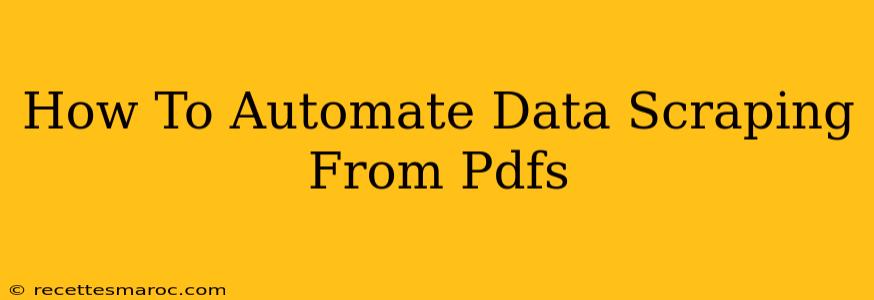Extracting data from PDFs can be a tedious and time-consuming task, especially when dealing with numerous documents. Manually copying and pasting data is inefficient and prone to errors. Fortunately, automating the process of data scraping from PDFs is entirely possible, saving you significant time and effort. This guide will walk you through effective methods for automating this process.
Understanding the Challenges of PDF Data Scraping
PDFs, unlike structured formats like CSV or XML, present unique challenges for automation. The layout and structure of a PDF can vary significantly, making it difficult to consistently locate and extract the desired information. Furthermore, PDFs can contain images, tables, and complex formatting that require sophisticated techniques to handle.
Types of PDFs and Their Impact on Scraping
Not all PDFs are created equal. Some are image-based scans, while others are text-based. Image-based PDFs are the most challenging to scrape, often requiring Optical Character Recognition (OCR) before data extraction. Text-based PDFs, on the other hand, are generally easier to handle, though their varying structures can still pose difficulties.
Methods for Automating PDF Data Scraping
Several methods exist for automating PDF data scraping, ranging from simple scripting to advanced libraries and tools:
1. Using Python Libraries
Python is a powerful language well-suited for data scraping. Libraries like PyPDF2, pdfplumber, and camelot provide functionalities for interacting with PDFs and extracting data.
PyPDF2: Excellent for basic text extraction from PDFs. However, it struggles with complex layouts and tables.
pdfplumber: Offers more advanced features, including table extraction and handling of complex layouts. It's a strong choice for many PDF scraping tasks.
Camelot: Specifically designed for extracting data from tables within PDFs. It’s incredibly useful when you need to extract tabular information accurately.
Example (pdfplumber):
import pdfplumber
with pdfplumber.open("your_pdf.pdf") as pdf:
first_page = pdf.pages[0]
text = first_page.extract_text()
print(text)
Remember to replace "your_pdf.pdf" with your actual file path.
2. Utilizing Online PDF Scraping Tools
Several online tools offer PDF scraping capabilities. These tools often provide a user-friendly interface and require no coding skills. However, they may have limitations in terms of features, the number of documents they can process, and data privacy concerns. Always check the terms of service and security measures of any tool before using it.
3. Employing RPA (Robotic Process Automation) Tools
For complex workflows involving multiple steps beyond just PDF scraping (e.g., data validation, database updates), Robotic Process Automation (RPA) tools are a powerful solution. These tools can automate entire processes, including PDF data extraction, making them ideal for large-scale operations.
Choosing the Right Method
The best method for automating PDF data scraping depends on several factors:
- Complexity of the PDFs: Simple, text-based PDFs might only need
PyPDF2, while complex PDFs might requirepdfplumberor even RPA tools. - Technical skills: If you're comfortable with Python programming, using libraries offers the most flexibility and control. Otherwise, online tools or RPA solutions are viable alternatives.
- Scale of the project: For small projects, a single script might suffice. For large-scale projects, RPA tools are often the most efficient.
- Data privacy: Carefully consider the security and privacy implications of any method, particularly when dealing with sensitive information.
Best Practices for Automated PDF Scraping
- Test thoroughly: Always test your chosen method on a sample of PDFs to ensure accuracy and identify potential issues.
- Error handling: Implement robust error handling to gracefully handle unexpected situations, such as corrupted PDFs or unexpected formatting.
- Data cleaning: After extraction, data cleaning is crucial to ensure data quality and consistency.
- Regular updates: Keep your chosen tools and libraries updated to benefit from bug fixes and new features.
By following these methods and best practices, you can significantly streamline your workflow and efficiently extract valuable data from PDFs, ultimately improving productivity and decision-making. Remember to always respect copyright and data privacy regulations when scraping PDFs.

